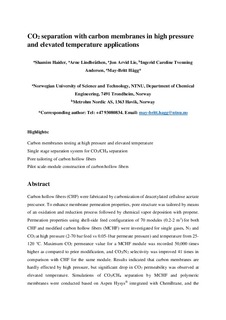| dc.contributor.author | Haider, Shamim | |
| dc.contributor.author | Lindbråthen, Arne | |
| dc.contributor.author | Lie, Jon Arvid | |
| dc.contributor.author | Andersen, Ingerid Caroline Tvenning | |
| dc.contributor.author | Hagg, May-Britt | |
| dc.date.accessioned | 2018-08-27T08:00:01Z | |
| dc.date.available | 2018-08-27T08:00:01Z | |
| dc.date.created | 2017-08-21T12:46:57Z | |
| dc.date.issued | 2017 | |
| dc.identifier.citation | Separation and Purification Technology. 2017, 190 177-189. | nb_NO |
| dc.identifier.issn | 1383-5866 | |
| dc.identifier.uri | http://hdl.handle.net/11250/2559376 | |
| dc.description.abstract | Carbon hollow fibers (CHF) were fabricated by carbonization of deacetylated cellulose acetate precursor. To enhance membrane permeation properties, pore structure was tailored by means of an oxidation and reduction process followed by chemical vapor deposition with propene. Permeation properties using shell-side feed configuration of 70 modules (0.2–2 m2) for both CHF and modified carbon hollow fibers (MCHF) were investigated for single gases, N2 and CO2 at high pressure (2–70 bar feed vs 0.05–1 bar permeate pressure) and temperature from 25–120 °C. Maximum CO2 permeance value for a MCHF module was recorded 50,000 times higher as compared to prior modification, and CO2/N2 selectivity was improved 41 times in comparison with CHF for the same module. Results indicated that carbon membranes are hardly effected by high pressure, but significant drop in CO2 permeability was observed at elevated temperature. Simulations of CO2/CH4 separation by MCHF and polymeric membranes were conducted based on Aspen Hysys® integrated with ChemBrane, and the process was optimized for cost calculation based on membrane area and compression energy. Simulation results indicated that the required separation can be achieved by a single stage process for MCHF, while a two-stage process is needed for the polymeric membranes. | nb_NO |
| dc.language.iso | eng | nb_NO |
| dc.publisher | Elsevier | nb_NO |
| dc.rights | Attribution-NonCommercial-NoDerivatives 4.0 Internasjonal | * |
| dc.rights.uri | http://creativecommons.org/licenses/by-nc-nd/4.0/deed.no | * |
| dc.title | CO2 separation with carbon membranes in high pressure and elevated temperature applications | nb_NO |
| dc.type | Journal article | nb_NO |
| dc.type | Peer reviewed | nb_NO |
| dc.description.version | acceptedVersion | nb_NO |
| dc.source.pagenumber | 177-189 | nb_NO |
| dc.source.volume | 190 | nb_NO |
| dc.source.journal | Separation and Purification Technology | nb_NO |
| dc.identifier.doi | 10.1016/j.seppur.2017.08.038 | |
| dc.identifier.cristin | 1487616 | |
| dc.description.localcode | © 2017. This is the authors’ accepted and refereed manuscript to the article. Locked until 16.8.2019 due to copyright restrictions. This manuscript version is made available under the CC-BY-NC-ND 4.0 license http://creativecommons.org/licenses/by-nc-nd/4.0/ | nb_NO |
| cristin.unitcode | 194,66,30,0 | |
| cristin.unitname | Institutt for kjemisk prosessteknologi | |
| cristin.ispublished | true | |
| cristin.fulltext | postprint | |
| cristin.qualitycode | 1 | |

